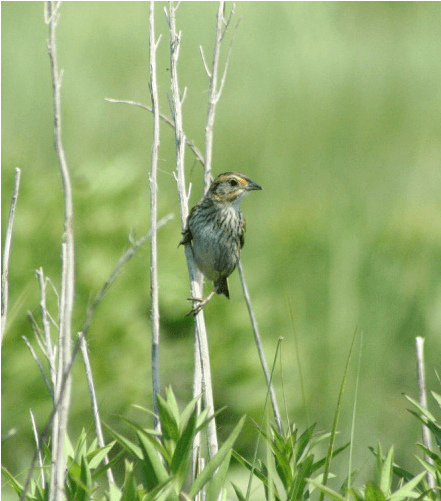(June 17, 2015, The Auk: Ornithological Advances)—Among birds, the line between species is often blurry. Some closely related species interbreed where their ranges overlap, producing hybrid offspring that can even backcross with either parent species, until a whole population of mixed-species birds forms in the area and creates what’s known as a “hybrid zone.” In the coastal marshes of New England, this has been happening between two sparrows—Saltmarsh Sparrow and Nelson’s Sparrow. A new study published this week in The Auk: Ornithological Advances shows that appearance alone is not enough to identify these hybrid zone birds: there is no single, intermediate “phenotype” or physical appearance common to all of the first-generation hybrids found, and birds from further backcrossed generations were often indistinguishable from the parent species. Fifty percent of birds identified as “pure” Nelson’s or Saltmarsh Sparrows in the field turned out be the descendants of hybrids when their DNA was analyzed.
Jennifer Walsh and Adrienne Kovach of the University of New Hampshire, along with Gregory Shriver of the University of Delaware, Brian Olsen of the University of Maine, and Kathleen O’Brien of the U.S. Fish and Wildlife Service, collaborated on this project to capture and examine the birds in the hybrid zone on the coast of Maine, New Hampshire, and Massachusetts. Each bird was classified based on its appearance as a Saltmarsh Sparrow, Nelson’s Sparrow, or a hybrid, and then a blood sample was taken so that the accuracy of this identification could be double-checked with DNA.
“Hybridization between species is quite common in birds and we often assume that the hybrids are going to be obvious intermediates between parental species. By combining detailed data on each bird’s appearance with genetic data that clearly identifies hybrids, Walsh and her colleagues have nicely demonstrated that the world is much more complex and that, in the case of these sparrows, the number of hybrids is much higher than we previously knew. This result is particularly relevant given the threats that saltmarsh nesting birds currently face,” says Chris Elphick of the University of Connecticut, an expert on tidal marsh birds who was not involved with the study.
Walsh and her colleagues recommend that future studies of hybrid zone birds need to include DNA sampling to confirm field identifications. Both species are considered high priorities for conservation in the region, and the Saltmarsh Sparrow in particular is considered globally vulnerable to extinction. In order to ensure that both species have a secure future, the first step is making sure we know for certain which is which.
“Sampling for this study was a big undertaking,” says Walsh, who carried out the study as part of her Ph.D. work. “We sampled 34 sites, spanning about 750 km. Traveling to and accessing all the sites was logistically challenging and we had a lot of support from USFWS and other conservation partners. Every marsh is hugely different in terms of bird density and accessibility. You never really know what to expect until you get there—some days we would trap 10 birds in 2 hours, some days we would trap 2 birds in 12 hours! In general, salt marshes are challenging too—there are a lot of holes and mud and ditches, and you are always working around the tides. It is amazing how quickly the marsh changes—very accessible at low tide, but at high tide you can find yourself swimming back.”

Saltmarsh Sparrows (shown) produce hard-to-identify hybrids with Nelson’s Sparrows. Image credit: K. Papanastassiou
Relationship of phenotypic variation and genetic admixture in the Saltmarsh–Nelson’s sparrow hybrid zone is available at http://www.aoucospubs.org/doi/full/10.1642/AUK-14-299.1. Contact: Adrienne I. Kovach, adrienne.kovach@unh.edu.
About the journal: The Auk: Ornithological Advances is a peer-reviewed, international journal of ornithology that began in 1884 as the official publication of the American Ornithologists’ Union. In 2009, The Auk was honored as one of the 100 most influential journals of biology and medicine over the past 100 years, and it currently holds the top impact factor among ornithological journals.